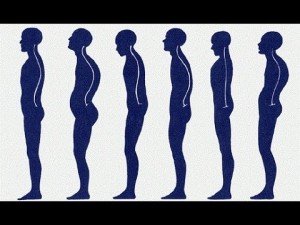The problem of poor posture
Exercises to improve posture are so important. As with so many areas of health and fitness, the subject of posture has increasingly come under review. The old school way of describing the muscular-skeletal system was to compare it to a network of pulleys and levers. As such, it was believed that if the muscles (the pulleys) were pulling too tight on the bones (the levers) then this would create imbalances that lead to poor posture.
The goal was to redress muscle imbalances in terms of strength and weaknesses and to relieve areas of muscle tension. Exercise can still help to address postural problems, but it is useful to put posture in its proper context first.

Exercises to improve posture
Improving posture
It turns out that poor posture is as much driven by what is going on in our head as it is by what is going on in our bodies. The postures that we adopt send of emotional and psychological signals, both to others and to ourselves.
We’ve all heard the phrase non-verbal communication. It is a phrase that reminds us that our body positions have a part to play in how we signal our emotions to the outside world.
If we are in a mental ‘slump’ the chances are that the body will reflect that, we will quite literally become slumped in our body.
But conversely, if we lift up our spines, raise our heads, lift our chests and even force ourselves to smile, this can have a corresponding impact on our moods. Even if it feels like we are faking it, it will still have a positive effect.
The other aspect of posture that we need to be conscious of before we move onto exercises is the role of habit. Most of our postures result from our habitual physical responses to everyday physical challenges (like sitting at a desk for 8 hours!).
It helps to have visual or auditory reminders at your workstation to prompt you to scan your body position and make corrections as you go through your day.
Two Simple exercises to improve posture
The Plank is an exercise that is often used to help with posture. Lying face down on the floor, you prop yourself up with your forearms and toes. It is important to keep the legs straight, and hips should be up. This should help to create a rigid line from head to toe. The abdominal muscles should be firing the whole time.
The second often overlooked exercise is the bridge. The bridge is performed by lying on your back with your knees bent and heels close to your bottom. The feet should be shoulder-width apart and flat on the floor. Raise your hips to create a straight line from your knees to your shoulders. As you come up, tighten your abdominals and buttocks. Lower yourself gently to the starting position and repeat a handful of times.
It is also helpful to strengthen the upper back and to stretch out the pectoral muscles. For best results, make sure you get supervised guidance on how to incorporate these exercises into your normal routine.
We hope this information is useful for you. If you have any questions about our treatments, please contact us. You can find us in Islington and Mill Hill Broadway . If you like this blog, please share!
We are always happy to help.



